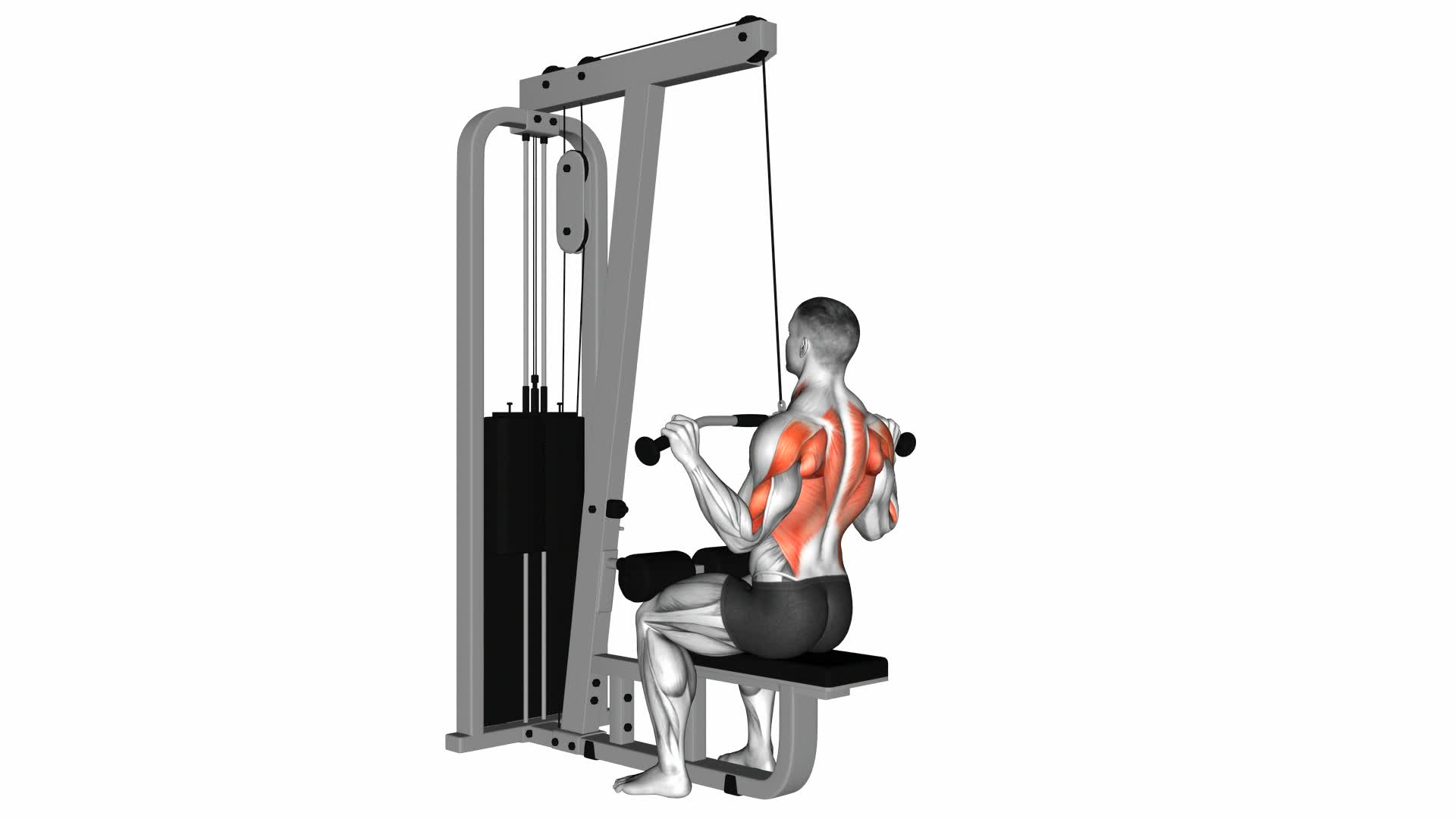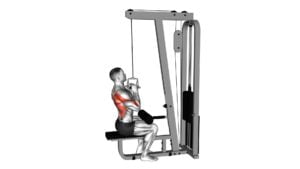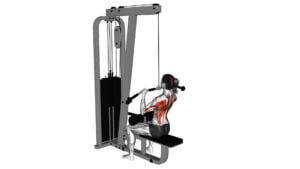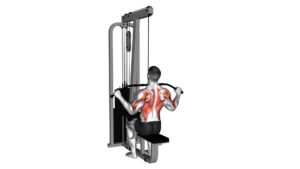Cable Bar Lateral Pulldown – Video Exercise Guide & Tips

Looking to strengthen your upper body and build a stronger back? The cable bar lateral pulldown is a great exercise for you.
Watch This Exercise Video
In this video exercise guide, we'll show you the proper form and technique, as well as variations and modifications to target different muscle groups.
Maximize your results with these tips.
Let's get started!
Key Takeaways
- Cable Bar Lateral Pulldown improves upper body strength and muscle definition.
- It is highly beneficial for injury prevention and muscle engagement.
- The exercise targets the muscles in the upper back, specifically the latissimus dorsi or 'lats'.
- It promotes proper posture by targeting the muscles responsible for stabilizing the shoulder blades.
Benefits of Cable Bar Lateral Pulldown
You will experience improved upper body strength and muscle definition through regular practice of the cable bar lateral pulldown exercise. This exercise is highly beneficial for injury prevention and muscle engagement.
The cable bar lateral pulldown exercise targets the muscles in your upper back, specifically the latissimus dorsi or 'lats.' By engaging these muscles, you can develop a strong and well-defined back.
One of the key benefits of this exercise is its ability to prevent injuries. The cable bar lateral pulldown helps to strengthen the muscles surrounding your shoulder joint, reducing the risk of common shoulder injuries such as rotator cuff strains. It also promotes proper posture by targeting the muscles responsible for stabilizing your shoulder blades.
In addition to injury prevention, the cable bar lateral pulldown is an excellent exercise for muscle engagement. It activates not only your lats but also your biceps, rhomboids, and trapezius muscles. This comprehensive engagement of multiple muscle groups promotes overall upper body strength and stability.
To maximize the benefits of the cable bar lateral pulldown, it's important to maintain proper form throughout the exercise. Use a weight that challenges you but allows for controlled movements. Focus on squeezing your shoulder blades together as you pull the bar down, and avoid using momentum to complete the movement.
Incorporating the cable bar lateral pulldown into your workout routine can lead to improved upper body strength, muscle definition, and injury prevention.
Equipment and Set-up for Cable Bar Lateral Pulldown
To properly set up for the cable bar lateral pulldown exercise, ensure that you have the necessary equipment and a secure attachment point for the cable bar. The first step is to locate the cable machine in your gym or home gym.
The cable bar attachment is essential for this exercise, as it allows you to grip the bar with both hands and perform the lateral pulldown motion. Once you have the cable bar attachment, attach it to the cable machine using the provided hooks or clips. Make sure it's securely fastened to prevent any accidents or injuries during your workout.
Next, select the appropriate weight for your fitness level and goals. Most cable machines have weight stacks that you can adjust by inserting the pin into the desired weight plate. It's important to choose a weight that challenges you but still allows you to maintain proper form throughout the exercise.
Proper Form and Technique for Cable Bar Lateral Pulldown
To perform the cable bar lateral pulldown exercise with proper form and technique, focus on maintaining a strong grip and engaging your back muscles throughout the movement. This exercise primarily targets the latissimus dorsi, which are the large muscles in your back responsible for pulling movements. It also works the muscles in your upper back, including the rhomboids and trapezius, as well as the biceps.
One common mistake to avoid is using too much momentum. It's important to control the movement and avoid swinging or jerking the weight. This can lead to ineffective targeting of the muscles and increase the risk of injury.
Another mistake is using a grip that's too wide or too narrow. A wide grip can put excessive strain on the shoulders, while a narrow grip can limit the range of motion and reduce the effectiveness of the exercise. Find a grip width that allows you to comfortably pull the bar down towards your chest while keeping your elbows in line with your wrists.
Remember to keep your chest lifted and your shoulder blades pulled down and back throughout the exercise. This will help to engage and activate the targeted muscle groups properly.
Variations and Modifications for Cable Bar Lateral Pulldown
While performing the cable bar lateral pulldown, you can incorporate variations and modifications to target different muscle groups and add variety to your workout routine. Here are three variations and modifications you can try:
- Wide Grip: Instead of using a shoulder-width grip, widen your grip on the bar. This variation places more emphasis on your outer back muscles, specifically the latissimus dorsi. It helps to develop a wider and more defined back.
- Close Grip: Conversely, you can bring your hands closer together on the bar. This modification shifts the focus to your inner back muscles, such as the rhomboids and middle trapezius. It helps to improve posture and strengthen the muscles responsible for scapular retraction.
- Underhand Grip: Instead of using an overhand grip, try using an underhand grip. This modification targets your biceps more effectively, making it a great way to work on both your back and arm muscles simultaneously.
Tips for Maximizing Results With Cable Bar Lateral Pulldown
To maximize your results with the cable bar lateral pulldown, focus on maintaining proper form and technique throughout the exercise. By doing so, you'll ensure that you're activating the targeted muscles effectively and avoiding common mistakes that can hinder your progress.
One common mistake to watch out for is using too much weight. It's important to choose a weight that allows you to perform the exercise with proper form. Using excessive weight can lead to using momentum instead of your muscles to perform the movement, resulting in less muscle activation and potential injury.
Another mistake is failing to engage your back muscles fully. To get the most out of the cable bar lateral pulldown, focus on squeezing your shoulder blades together as you pull the bar down. This will help activate your latissimus dorsi, which is the primary muscle targeted in this exercise.
Additionally, it's crucial to avoid using your biceps excessively during the movement. While your biceps assist in the exercise, the main focus should be on your back muscles. To ensure proper muscle activation, concentrate on initiating the movement with your back muscles and keeping tension on them throughout the entire range of motion.
Frequently Asked Questions
How Many Sets and Reps Should I Do for the Cable Bar Lateral Pulldown?
For the cable bar lateral pulldown, you'll want to focus on both sets and reps. The number of sets and reps will depend on your fitness goals and current abilities.
Start with a weight that challenges you but allows for proper form. Aim for around 3-4 sets of 8-12 reps to build strength and muscle.
You can also vary the exercise by using different grip widths or adding modifications like resistance bands for added difficulty.
Can I Use Different Attachments for the Cable Bar Lateral Pulldown Exercise?
Yes, you can use different attachments for the cable bar lateral pulldown exercise. Using different attachments allows you to target different muscles and add variety to your workout routine.
The benefits of cable exercises include improved muscle strength, stability, and coordination. By using different attachments, you can engage different muscle groups and challenge your body in new ways.
It's a great way to keep your workouts interesting and continue making progress.
Is It Necessary to Warm up Before Performing the Cable Bar Lateral Pulldown?
It's important to warm up before performing the cable bar lateral pulldown. Warming up helps increase blood flow to your muscles and prepares them for the exercise. It also reduces the risk of injury.
Make sure to do some light cardio and dynamic stretches to warm up your entire body.
When doing the cable bar lateral pulldown, common mistakes to avoid include using too much weight, using improper form, and not engaging your core muscles.
Can I Perform the Cable Bar Lateral Pulldown Exercise if I Have Shoulder Pain or Injury?
Should you avoid the cable bar lateral pulldown exercise if you have shoulder pain or injury?
It's important to consider your shoulder condition before performing this exercise. Shoulder pain or injury can be aggravated by the cable bar lateral pulldown, so it may be wise to avoid it.
However, if you still want to engage in this exercise, it's recommended to modify it to minimize stress on your shoulder.
Always prioritize your safety and consult with a professional if needed.
Should I Incorporate the Cable Bar Lateral Pulldown Into My Back Workout or Shoulder Workout Routine?
Incorporating the cable bar lateral pulldown into your workout routine can bring several benefits.
It targets the muscles in your back, helping to strengthen and tone them.
This exercise also engages your shoulders and arms, providing an effective upper body workout.
To perform it correctly, maintain proper form and technique.
Keep your back straight, pull the bar towards your chest, and squeeze your shoulder blades together.
Remember to start with a weight that allows you to maintain good form throughout the exercise.
Conclusion
In conclusion, the Cable Bar Lateral Pulldown is a highly effective exercise that targets the muscles in your back and arms. By using proper form and technique, and making use of variations and modifications, you can maximize your results with this exercise.
Incorporating the Cable Bar Lateral Pulldown into your workout routine can help you build strength, improve posture, and enhance overall upper body muscle development.
So grab a cable bar and start pulldown for a stronger and more sculpted upper body.

Author
Years ago, the spark of my life’s passion ignited in my mind the moment I stepped into the local gym for the first time. The inaugural bead of perspiration, the initial endeavor, the very first surge of endorphins, and a sense of pride that washed over me post-workout marked the beginning of my deep-seated interest in strength sports, fitness, and sports nutrition. This very curiosity blossomed rapidly into a profound fascination, propelling me to earn a Master’s degree in Physical Education from the Academy of Physical Education in Krakow, followed by a Sports Manager diploma from the Jagiellonian University. My journey of growth led me to gain more specialized qualifications, such as being a certified personal trainer with a focus on sports dietetics, a lifeguard, and an instructor for wellness and corrective gymnastics. Theoretical knowledge paired seamlessly with practical experience, reinforcing my belief that the transformation of individuals under my guidance was also a reflection of my personal growth. This belief holds true even today. Each day, I strive to push the boundaries and explore new realms. These realms gently elevate me to greater heights. The unique combination of passion for my field and the continuous quest for growth fuels my drive to break new ground.







